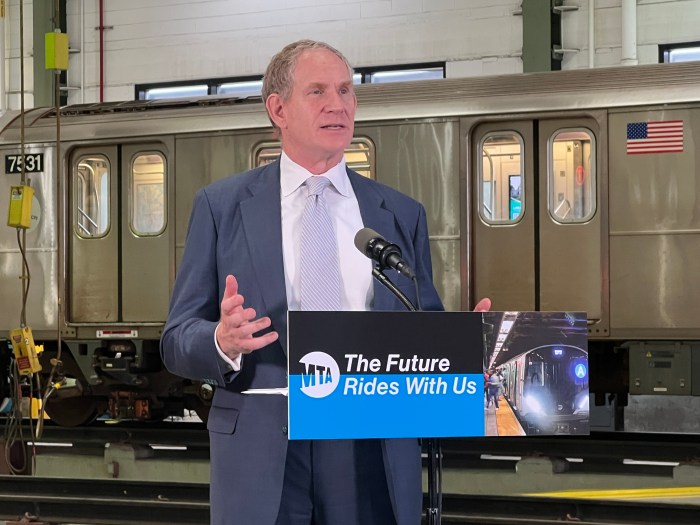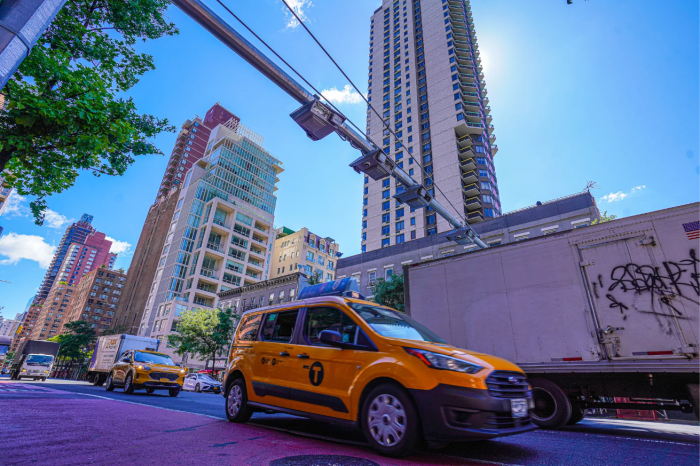Queens and Brooklyn are the only boroughs not separated by a body of water, but direct public transit options between the two often can be tedious and time consuming.
Enter: the Brooklyn-Queens Connector, Mayor Bill de Blasio’s proposed streetcar that would link Queens and Brooklyn without having to pass through Manhattan.
The streetcar proposal, however, has been met with resistance. Politicians questioned its feasibility last summer after a report from the city revealed a shorter, more expensive route that would take longer to build and require over $1 billion in federal funding.
The City Council held a hearing Thursday to discuss the merits and drawbacks of the project, and some lawmakers and officials wondered whether a bus rapid transit route would be a better option.
Read on to learn more about the streetcar, funding and fare, potential issues and more.
What is the Brooklyn-Queens Connector?
The Brooklyn-Queens Connector, commonly called BQX, is a proposed zero-emission streetcar that would run along 11 miles of waterfront between Astoria and Red Hook.
Where would the BQX stop?
A report released by the city Economic Development Corporation in August outlined potential BQX stops in 11 areas:
- Astoria
- Queensbridge
- Long Island City
- Newtown Creek Bridge Crossing
- Greenpoint
- Williamsburg
- Brooklyn Navy Yard
- Downtown Brooklyn
- Atlantic Avenue
- Columbia Street Waterfront
- Red Hook
Why is the route along the waterfront?
As economic hubs in Brooklyn and Queens continue to grow, and more New Yorkers commute between the two boroughs, the de Blasio administration aims to create public transit options that don’t follow the Manhattan-centric model that the subways were built on.
The streetcar is projected to increase mobility between Queens and Brooklyn for about 400,000 New Yorkers who live along the waterfront. The BQX also would link up to 13 subway routes, over 30 bus lines and nine ferry landings, according to the EDC report.
De Blasio said the streetcar could save some interborough commuters up to 20 minutes in daily travel time.
Critics, however, have pointed out that the proposed route serves many of the same communities that have access to the G train.
How much would the BQX cost to ride?
The fare for a single ride would be set at $2.75, which is the same cost as a swipe of a MetroCard (for now). Customers would be able to transfer for free to connecting MTA subway and bus routes.
When would the project be completed?
If the proposal is approved by the City Council in its current form, the BQX would be completed by 2029. But first, the city has to finish conducting an environmental impact review. Once the review is completed, which is expected to be by this fall, the proposal will need to go through the city’s Uniform Land Use Review Procedure (ULURP) — a series of governmental hoops the project will need to jump through before it lands at the feet of the City Council for a vote.
Where is the funding coming from?
The project is expected to cost $2.7 billion to complete. The streetcar would generate about $30 billion in economic impact and up to $1.4 billion through a financing tactic called value capturing. Initially, de Blasio said the entire project would be paid for through value capturing, which involves increasing tax revenue and rising property tax values along the route, but the EDC’s report showed it would only cover about half of the cost. The other half of the funding would come from the federal government.
Though construction is not expected to begin until 2024 at the earliest, the city has already spent $7.5 million on project development via EDC funds and Department of Transportation staffing hours, according to Chris Hrones, the DOT’s director of Strategic Transit Initiatives.
What concerns have been raised about the BQX?
In addition to the route being too similar to the G train, critics have questioned the resiliency of an above-ground transportation system being constructed so close to flood-prone areas. Others, including City Councilman Jimmy Van Bramer, have pointed out that de Blasio would no longer be in office by the streetcar’s expected completion date in 2029.
"We need solutions and we need them now,” Van Bramer said of the streetcar project in October.
Van Bramer also has questioned whether the city would be able to obtain the federal funding it needs for the project if President Donald Trump is re-elected.
Tom Angotti, professor emeritus of Urban Policy and Planning at Hunter College, has said he could see the BQX streetcar becoming a zombie project that the next mayor could eliminate.
With Vincent Barone



































